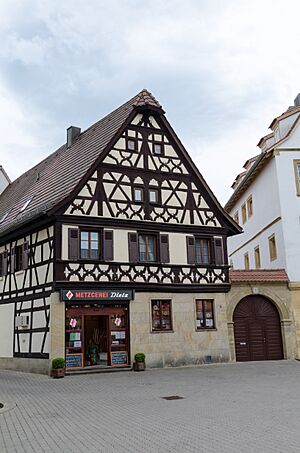Hallstadt facts for kids
Quick facts for kids
Hallstadt
|
||
|---|---|---|

Church of Saint Kilian
|
||
|
||
| Country | Germany | |
| State | Bavaria | |
| Admin. region | Oberfranken | |
| District | Bamberg | |
| Elevation | 239 m (784 ft) | |
| Population
(2022-12-31)
|
||
| • Total | 8,876 | |
| Time zone | CET/CEST (UTC+1/+2) | |
| Postal codes |
96103
|
|
| Dialling codes | 0951 | |
| Vehicle registration | BA | |
| Website | www.hallstadt.de | |
Hallstadt is a town in Germany, located in the Upper Franconian area of Bamberg. It sits on the left side of the Main River, about 4 kilometers (2.5 miles) north of the city of Bamberg.
Contents
Geography of Hallstadt
Hallstadt is located right next to the city of Bamberg in the south. To its west, you'll find the Main River. The town is made up of two main parts: Hallstadt itself (with about 7,588 people) and Dörfleins (with about 1,380 people). These areas are also known as Gemarkungen, which are traditional land units often named after a nearby town or village.
History of Hallstadt
Long ago, around 5000 BC, people were already living and farming in the Hallstadt area. This has been shown by archaeological discoveries.
Early History and Important Figures
Around the year 670, Saint Kilian, a famous religious leader from Franconia, preached in Hallstadt. About 50 years later, another important figure, Saint Boniface, tried to teach the people of Hallstadt about his beliefs.
The town was first officially mentioned in a document between 741 and 747. It was called Halazestat im Radensgove. This document was from the Frankish Dukes Karlmann and Pepin the Short. In 793, Charlemagne, a very powerful king, agreed to his father Pepin's gifts to the Bishop of Würzburg, which included Halazestat.
Between 794 and 820, the Church of St. Kilian in Hallstadt was built. It was one of 14 churches Charlemagne had built for Slavic communities. In 805, Hallstadt became a royal court for Charlemagne, meaning it was an important place for the king.
Changes Over the Centuries
Two hundred years later, in 1007, Emperor Henry II gave the royal court in Hallstadt to the Bishopric of Bamberg, which he had just started. In 1013, he traded some land to get Hallstadt's church and parish from the Bishop of Würzburg.
When a bridge was built across the Main River by Bishop Lambert von Brun, Hallstadt became an important place for trade. However, in 1430, the town was burned down by the Hussites, a religious group. By 1503, Hallstadt had recovered enough to be called a market town. But in 1553, it was attacked and destroyed again by Margrave Albrecht Alcibiades von Brandenburg-Kulmbach.
Difficult Times
From 1617 to 1618, sad events known as witch trials took place. During this time, 53 people from Hallstadt were put to death. Just three years earlier, many people had died from the plague. Then, in 1633, Hallstadt was burned down again during the Thirty Years' War, a major conflict in Europe.
Between 1756 and 1763, soldiers of Frederick the Great occupied Bamberg and Hallstadt several times.
Modern Era
In 1802, Max Joseph, who would later become King of Bavaria, took control of the area including Bamberg and Franconia. A few years later, in 1808, King Max visited Hallstadt. In 1818, a new law called the Gemeineedikt helped create the modern community of Hallstadt.
In 1880, Hallstadt became connected to the railway system, and its own railway station was opened.
Recent History of Hallstadt
In 1954, Hallstadt officially became a town and celebrated its 1,300th anniversary. In 1970, some parts of Hallstadt, like Bruckertshof and Kramersfeld, became part of Bamberg. A new bridge across the Main River, which started being built after World War II, was also finished. In 1972, the nearby community of Dörfleins joined Hallstadt.
Population Changes
In 1970, Hallstadt had 6,589 people. By 1987, it grew to 7,436, and in 2000, it had 8,427 residents. On June 30, 2004, there were 8,560 people, and in 2007, the population was 8,526.
Economy and Infrastructure
Hallstadt's Economy
In 1998, official records showed that 116 people worked in agriculture and forestry in Hallstadt. About 2,424 people worked in manufacturing businesses, and 1,182 worked in trade and transport. The biggest employer in town is a company called Josef Leicht Maschinenbau, which has over 380 workers. Many other people also work in different areas or from home. In 1999, there were 50 farms in the area, using 672 hectares (about 1,660 acres) of land for crops and meadows.
Education in Hallstadt
As of 2007, Hallstadt had:
- three kindergartens with space for 325 children
- one elementary school
Keeping People Safe
Different Aid organizations work to keep the people of Hallstadt safe. They help protect everyone, as well as buildings, waterways, and other important things in the town.
Land Rescue Services
For health emergencies on land, groups like the BRK (Bavarian Red Cross) and the Malteser Hilfsdienst (MHD, also known as the Order of Malta Ambulance Corps) provide rescue services. They help the town and the wider Bamberg district. These groups also have medical teams ready in case of a big disaster.
The Bavarian Red Cross has a special team called the BRK Bereitschaft Bamberg 3/Hallstadt. This team is responsible for the Red Cross's medical work in the Hallstadt area.
Water Rescue Services
For emergencies on the town's waterways, the Kreiswasserwacht (District Water Watch) Bamberg has a Hallstadt team. During summer weekends and holidays, they help staff the Hallstadt swimming pool, working alongside the pool's regular lifeguards.
Personalities
- Kaspar Schleibner (1863-1931), an art professor and painter
- Robert Pfleger (1906-1971), a chemist and business owner in the pharmaceutical field
See also
 In Spanish: Hallstadt para niños
In Spanish: Hallstadt para niños



